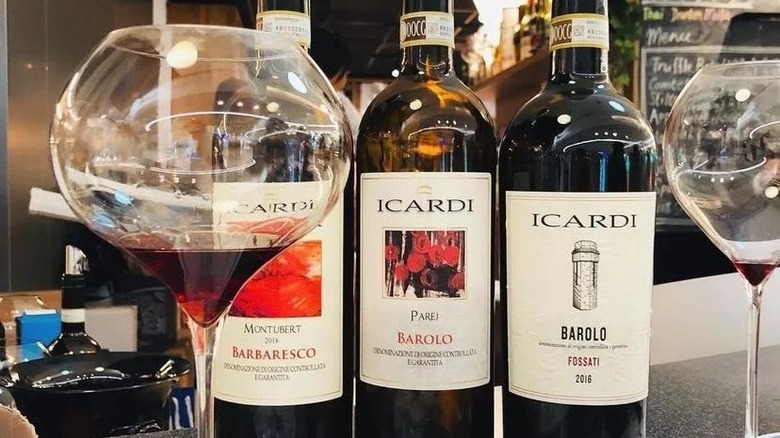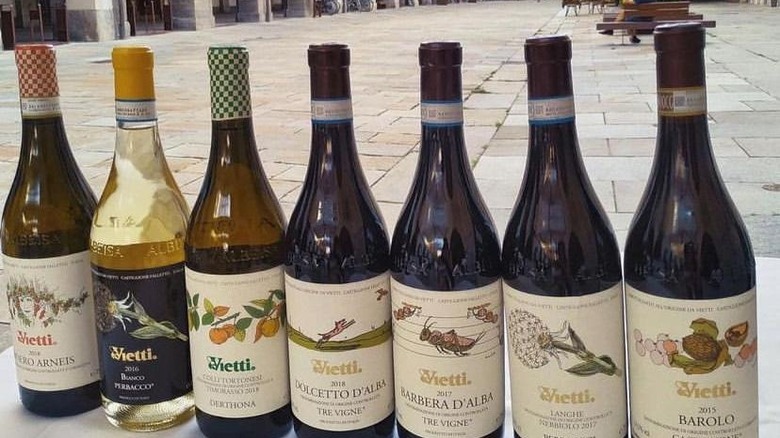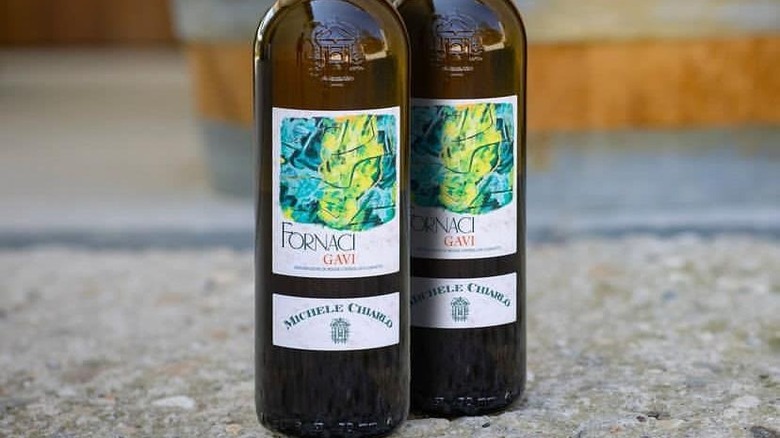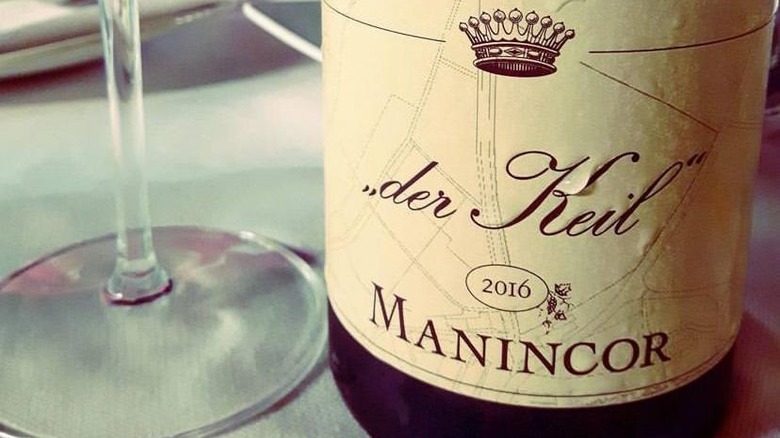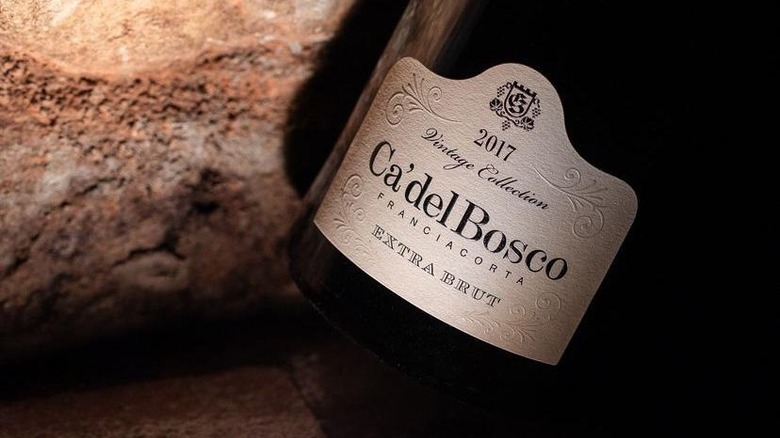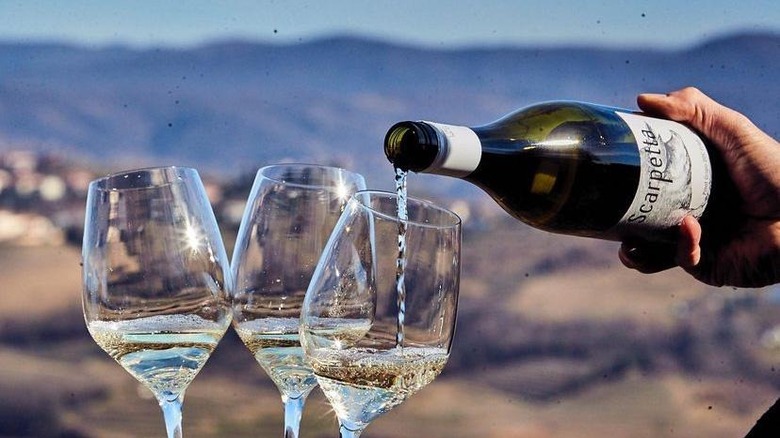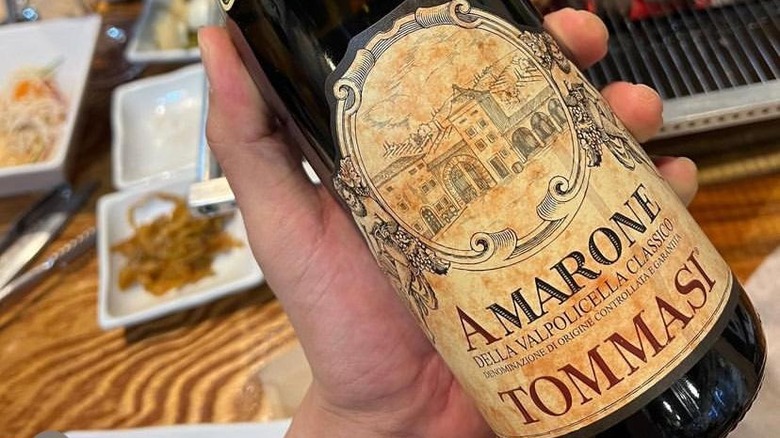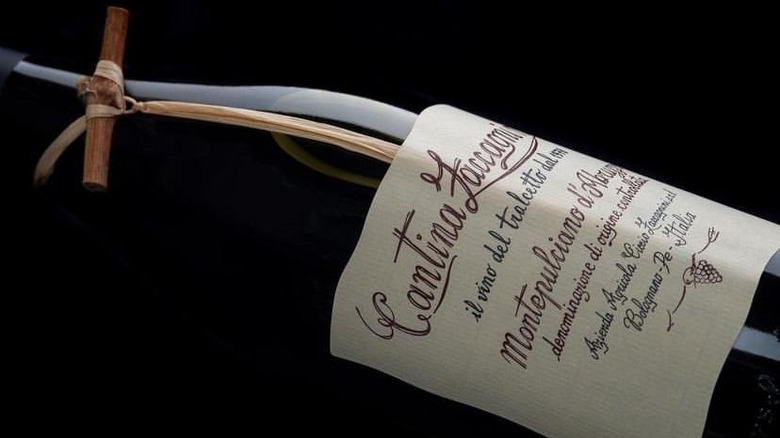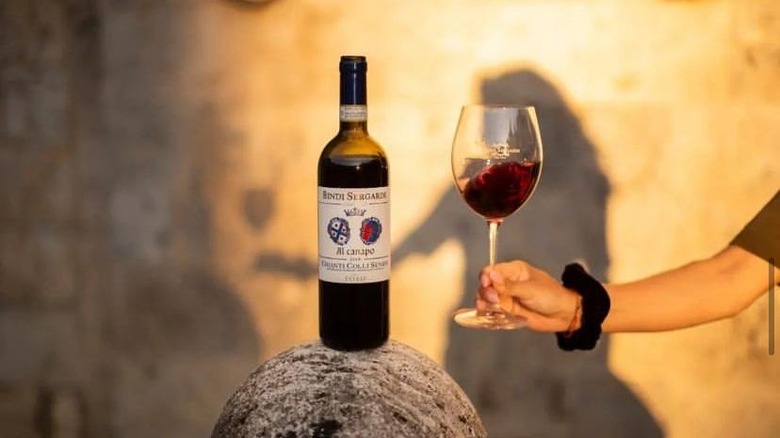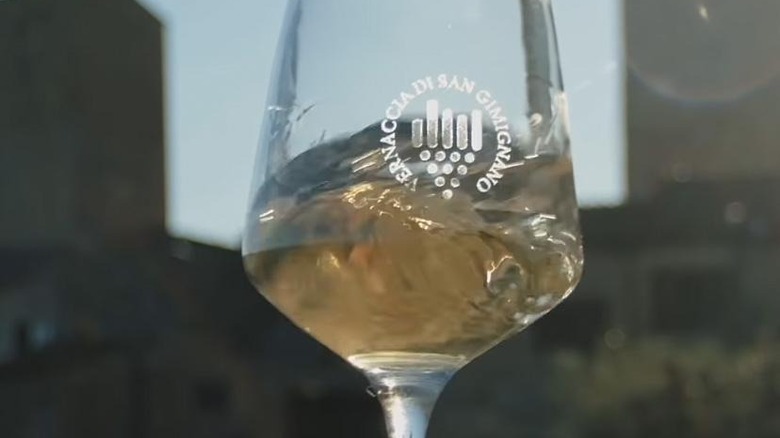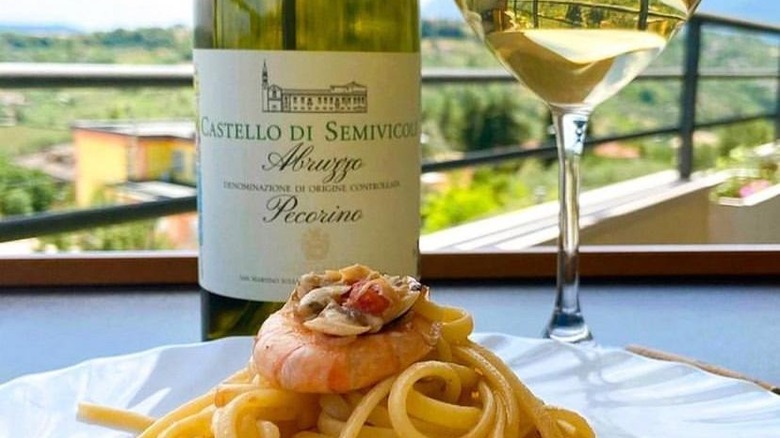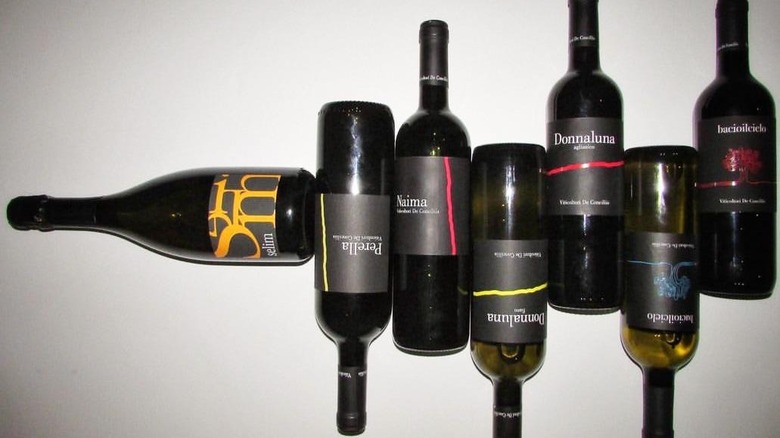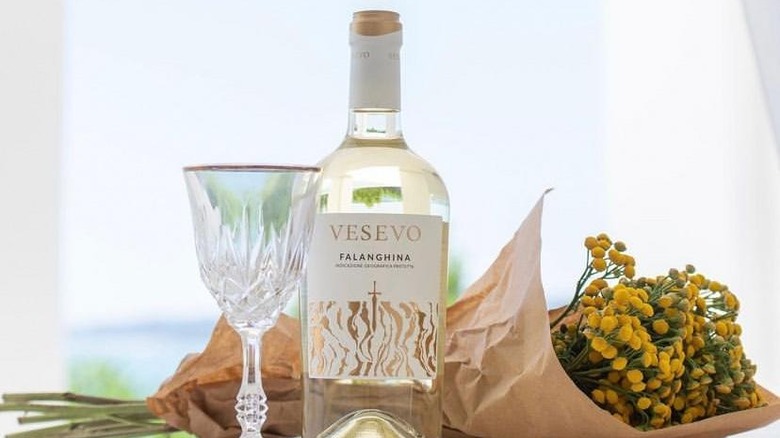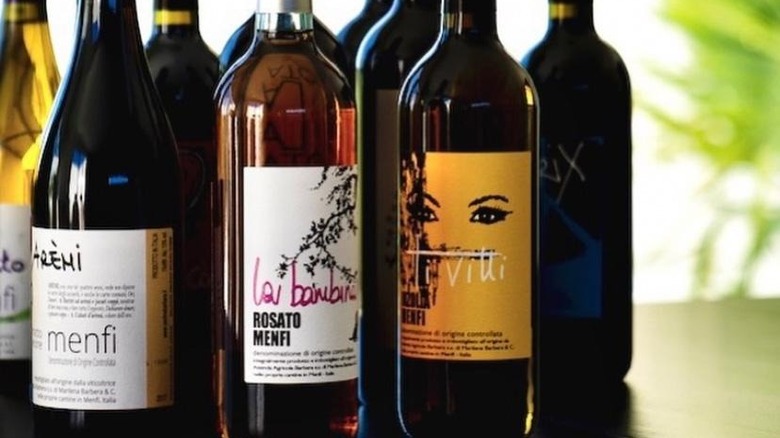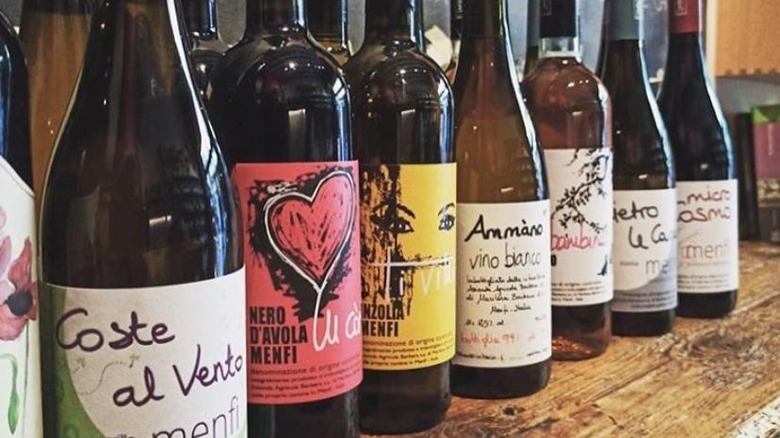Explore Italy With These 15 Wines
When we think of Italy, we imagine ancient cities filled with senators and gladiators, Roman conquerors, philosophers, and ingenuity. We envision bucolic rolling hills lined with statuesque poplar trees. We crave pasta, pizza, salumi, and cheese. And, if you're an oenophile, you think about Italian wine.
Rome, as Italy was once known, was the heart of the ancient world. It was a thriving trade center teeming with diverse cultures and cuisines. It was also one of the first European countries to grow wine grape vines. In Hugh Johnson's "The Story of Wine," he states that when the Greeks first arrived on the peninsula around 800 B.C., they found such an abundance of grape vines that they called the region Oenotria, or "the land of the staked vines." The Etruscan people living in the northern regions of the Italian peninsula at the time of the Greek invasion were skilled winemakers and likely invented trellising — a method of staking grapevines above ground to encourage growth and ease harvesting. It is the Etruscans who gave their name to Tuscany, one of the greatest wine regions in the world.
Italy is one of the top wine-producing countries and makes wine in every region. Italians produce major types of red wine, whites, oranges, rosés, fortified wines, and dessert wines, along with grape spirits. Italian wines are popular worldwide, and some believe that Italian grapes may be the future of vineyards as far as California — let's explore them through these 15 bottles.
Northwest: nebbiolo
Nebbiolo is a bold and flavorful grape with the perfect combination of high acidity and tannins, making it an enduring, age-worthy wine. Its inky purple color exudes aromas of violet, red rose petals, bramble, Morello cherries, spicy cigar box, cocoa, and clove. When it's young, it shows sharp blackberry and cranberry notes that temper with age, evolving into a spiced wine with notes of fresh figs, plums, cedar, and cola.
Nebbiolo is the grape of Barolo and Barbaresco, the king and queen of Italian wines. Barolo and barbaresco need time in the bottle to mature and can perfectly bloom after 15 to 25 years! When drunk young, the tannins can be harsh and gritty, and the flavors can resemble kirsch or blackberry liqueur.
Icardi is a small fifth-generation organic grape grower and wine producer that crafts a range of wines in the Piedmonte region, including moscato and barbera. But it's their Barolos that claim the top prize. Angelo Gaja is the preeminent Barolo and Barbaresco producer in the region crafting majestic wines with a modern touch. His family founded their wine company in 1859.
Northwest: barbera
In a region known for its rich, opulent, inky Barolo and Barbaresco wines that need decades in the bottle before they are accessible, an everyday drinker like barbera is a welcome addition to the table. Barbera also hails from Piedmonte, where it thrives in the rolling hills and diverse climates of the region. Its best expression grows in the region of Alba, and it's fruitier and more accessible than nebbiolo. It also has mouth-watering high acidity, but it doesn't have the brawny tannin structure of nebbiolo making it more accessible, earlier. In other words, drink it young. Barbera has riper, fruitier notes of tart cherry, blueberries, and raspberries, along with crushed dried herbs, licorice, black pepper, and spice. Barbera is an everyday drinker that pairs well with farmers' market salads, steamed and roasted vegetables, pasta dishes, burgers, pizza, and bolognese.
Vietti and Scarpetta are two legendary barbera producers that craft exceptional fruit-driven, balanced wines. Look for Vietti Barbera d'Alba Tre Vigne multi-vineyard barbera and Scarpetta Barbera del Monferrato.
Northwest: cortese
According to "Wine Grapes" by Jancis Robinson, Julia Harding, and José Vouillamoz, it is rare to find the ancient cortese grape outside of the northwest wine region called Piedmonte, where it is crafted into a fine white wine with racy acidity and soft aroma and flavor notes including lemon zest, tangerine peel, green strawberries, honeydew melon, and blanched almonds. Most often, cortese is used to produce a dry and aromatic wine called Gavi. It pairs beautifully with freshwater and saltwater fish, seafood, risotto alla Milanese (saffron risotto), and tagliatelle ai funghi with a generous shaving of white truffles.
Michele Chiarlo Gavi is light and lively, and its elevated acidity and ripe fruit make it age-worthy and a perfect food wine if consumed while young. Principessa Gavia Gavi is an austere, elegant wine that is true to cortese's classic style.
Northeast: schiava
Schiava is an obscure grape from the Alto Adige region nestled against the limestone-rich Dolomite mountain range. Many varieties of wine grapes crave the mineral content found in limestone soil, including chardonnay, pinot noir, cabernet franc, and sauvignon blanc. Schiava flourishes in these microclimates as well. A unique flavor profile, schiava exudes floral notes of rose petals and apple blossom, along with ripe strawberry and raspberry. This rare red wine also has hints of lemon and zesty mandarin that are finished off with smoky spice.
Schiava has moderate acidity and a woodsy dry finish, but it is a light wine that can be surprisingly refreshing. Pair it with simple fare, including pasta, pizza, roast chicken, grilled vegetables, soups, and stews.
Rarely exported from Italy, Manincor and J. Hofstatter both produce lively, fresh, fruity schiava that have availability in the United States. Look for Manincor 'Kaltersee Keil' Schiava Lago di Caldaro Classico Superiore and J. Hofstatter Kolbenhofer.
Northeast and central: Italian bubbly
While champagne may be the king of sparkling wines, Italy produces incredible bubbly, too — and for a fraction of the price. Most wine lovers have heard of prosecco, that sweet-tart easy drinking sparkling wine produced from the glera grape in northeastern Italy. It is light, refreshing, and simple. Unless it is of the highest quality, carbonated prosecco tends to be a wine lacking dimension, which makes it perfect for Aperol spritz and peach bellini cocktails.
If you want something substantial, look for Franciacorta and trentodoc. Both wines hail from the northernmost regions of Italy nestled in the foothills of the Alps. They are crafted using the classic method of primary fermentation in a tank or barrel and secondary (bubble-inducing) fermentation in the bottle, just like Champagne.
Both wines focus on chardonnay, with Franciacorta adding pinot nero (noir) to the mix, the foundational grapes for Champagne. Often, Franciacorta producers add pinot bianco grapes to their blend. Trentodoc and Franciacorta are aged on the lees for 15 to 36 months and have six sweetness levels that range from bone dry to demi-sec, a moderately sweet yet balanced sparkling wine.
Rotari makes a range of nine delicious bubbly wines, and Rotari Brut is available in the US market. Ca' del Bosco is also one of the most famous producers of premier Italian sparkling wine.
Northeast: pinot grigio
Pinot grigio, also known as pinot gris, is a naturally occurring mutation of the red pinot noir grape. It is a grayish pale pink hue that produces tangy, fresh, acidic wines with notes of peach, melon, white flowers, and chalky flavors. Pinot grigio/pinot gris can be found in New Zealand, Oregon, Germany, Hungary, Australia, and the Alsatian region of France. In Italy, pinot grigio thrives in the limestone soils to the northeast called the Veneto (just west of Venice) and in the foothills of the Dolomite mountains, reports Wine Insiders.
The best regions of pinot grigio are Collio in Friuli-Venezia Giulia and Alto Adige, where producers craft a steely vat wine with bright acidity, floral, and white peach aromas, and a palate that exhibits a hint of smoky salinity. Pinot grigio is a food-friendly, light, and refreshing aperitivo.
Villa Amoroso Pinot Grigio is a lively and fresh style of pinot grigio that focuses on elevated acidity and restrained fruitiness. Cesari and Scarpetta produce pinot grigio wines that are fruity and floral with herbal notes, making them a perfect apertivo or picnic wine.
Northeast: valpolicella
Valpolicella is a beautiful, fruit-driven, tangy red wine from the Veneto region to the west of Venice. Valpolicella is a complex blend of three regional grapes — corvina, molinara, and rondinella — that are rarely found outside of the region. Each grape brings its unique qualities to the blend, creating a balanced wine with tart cherry and red berry top notes layered with plums, pomegranate, cocoa, and spice. Valpolicella is crafted into five styles starting with valpolicella classico, the simplest style. Valpolicella superiore is aged longer, creating a concentrated wine with darker fruit and spice notes.
There are three more styles, each increasing in complexity, depth of flavor, and ripeness of fruit notes. For these styles, winemakers dry a variety of grapes on mats until they are slightly raisinated, which densely concentrates flavors and sugars. These dried grapes are used to craft amarone della valpolicella and make a rich, viscous wine with tremendous depth of flavor and notes of peppercorn, leather, cocoa, and dried and candied fruits. The juice for valpolicella superiore ripasso is blended with the remaining pressed and dried grapes from the amarone. The final style is a dessert wine called recioto della valpolicella that is perfumed with nutty molasses, maple sugar, dark chocolate, and caramel tones.
Tommasi has been producing award-winning, classic valpolicella, ripasso, amarone, and recioto since 1902. Zenato farms some of the oldest vineyards in the region and is known for its prized grapes. Try both with grilled fare, pizza, pasta, stews, and prime rib.
Central-east: montepulciano
Not to be confused with the exalted Tuscan sangiovese wine called Vino Nobile di Montepulciano, montepulciano is (also) a single grape varietal from the Marche and Abruzzo regions of Italy, says Wine Insider. Most often, it is called Montepulciano d'Abruzzo, which is the best montepulicano available. This wine is a juicy, fruity, simple drinker with notes of fresh black and red berries, ripe red cherries, red plum, currants, and fresh Italian herbs. The best specimens can be smoky, spicy, and jammy. Montepulciano isn't a long-lived wine, so drink it within a few years of its vintage date.
One of the most popular producers is Cantina Zacanini Montepulicano D.O.C., known for its classic, fruit-driven style called Tralcetto. Montepulciano pairs exceptionally well with casual dishes like burgers, grilled sausage, charcuterie cured meats, roasted vegetables, and pizza of all types. It shows best when served cool and consumed young.
Central and central-west: sangiovese
Tuscany is the land of sangiovese, an ancient grape that, per Wine Spectator, derives its name from the Latin, "Sanguis Jovis” or "blood of Jupiter," and is one of the best wines for a red wine spritzer. The grape is known for its elevated acidity, and notes of fresh strawberries, regional cherries, crushed herbs, dried orange peel, and spice. In Chianti and Chianti classico, we find ripe Morello cherries and tangy red raspberries with layers of crushed oregano and a signature spiciness that shines through the bright acidity before giving way to a moderate structure and slightly gritty tannin.
Brunello di Montalcino is famous for its single clone sangiovese grosso that imparts notes of rich sandalwood and a dusting of cocoa over Amarena Fabbri cherries and dark plums. Brunello offers hints of sweet tobacco, espresso, tomato leaf, and cured meats or wood smoke on the finish. Vino Nobile di Montepulciano is elegant and restrained amongst the Tuscan sangioveses but shines with lifted acidity, gentle strawberry and cherry fruit on a backdrop of silky roasted hazelnuts, mocha, and a sprinkling of cinnamon. Often notes of sweet balsamic vinegar, coffee, leather, and charcuterie salami can be found in oak-aged riserva and gran selezione bottles of sangiovese.
Look for Bindi-Sergardi, owned by the Bindi-Sergardi family, who has been producing wines for 24 generations in the same Chianti and Sienese vineyards. Try Tenuta Sette Cieli from Bolgheri for a richer, opulent style of sangiovese.
Central-west: vernaccia
Italy's Finest Wines reports that vernaccia is an ancient Italian grape that dates back more than 1,000 years in Tuscany. It can be a lively, fresh, wine with citrus zest and floral notes when young. Vernaccia has a lovely complexity, refinement, and finesse with bottle age that develops vanilla, marzipan, and spicy notes. It is often blended with another native white grape called trebbiano, which is herbal, lemony, and crisp with notes of just under-ripe stone fruit, apples, and citron. It has moderate acidity and a body with just a hint of sweetness. Vernaccia and trebbiano blend beautifully together to enhance the depth and body of the wine. When grown and crafted in San Gimignano, it can be exalted as Vernaccia di San Gimignano DOCG, a white wine with tremendous age-worthiness that's considered one of the most important white wines from Tuscany.
Tenuta Le Calcinaie di Simone Santini Vernaccia di San Gimignano DOCG is a classic version of the famed vernaccia that's worth seeking out for its historic style. Fattoria Poggio Alloro Vernaccia di San Gimignano DOCG is a modern take on the classic.
Central-east: pecorino
Pecorino is grown in the Marche and Lazio regions of central Italy, where it is called the grape of the shepherd and the sheep. It grows in the same environment as the sheep whose milk is used to craft the tangy, salty pecorino romano cheese that is ubiquitous in Roman cuisine (you'll find it in the indelible cacio de pepe pasta dish made with the cheese, freshly ground pepper, and little else). Pecorino wine is the perfect pairing for the dish, but it's also made for other traditional foods of the region, such as zucca di fiori pizza, savory supuli, seafood, calamari, and charcuterie.
Pecorino has a tangy citrus zest, minerality, and green herbal notes, that are refreshing and clean, as noted in "Wine Grapes" by Jancis Robinson, Julia Harding, and José Vouillamoz. Check out Vini Fantini pecorino and Umani Ronchi pecorino with your next Roman inspired lunch.
Southwest: aglianico
Aglianico is an ancient grape that was brought to Italy by the Greeks centuries before the common era. It took root in the volcanic soils of Mount Vulture and Mount Falerna in Campania near Naples and is distinguished by its gritty, smoky quality. Sweet white wines from the black grape produced bottles with incredible longevity according to Pliny the Elder, who wrote about vintages of Falernian (as it was called) lasting more than one hundred years (via 303Magazine). These days, aglianico produces a deep, inky, lush red wine with notes of bramble, black cherry, pepper, spice, and smoke, with a gamey, meaty quality and a long aromatic finish, according to Wine Folly.
Look for wines from Taurasi, Campania, Basilicata, or Calabria. Rocca Del Principe Aglianico Irpinia DOC strives for excellence in the intense, modern aglianico wines they produce. For something completely surprising, look for Bruno De Conciliis Selim Spumante, a light, fizzy, refreshing, and fruity organic wine crafted from the bold aglianico grape.
South-central: falanghina
Martha Stewart Wines reports that falanghina, from the rolling hills of Campania, is an ancient grape from Greece. Along with aglianico, it made some of the most legendary wines of antiquity. Falanghina is a lovely and lush wine with bright, fruity notes of ripe apricot, peach stone fruit, wildflower honey, white flowers, Meyer lemon, and spice. It is a fleshy, round white wine with moderate acidity and body that's a perfect afternoon quencher. Incredibly food-friendly, falanghina pairs beautifully with creamy pasta dishes, scallops, shrimp, grilled oysters, and clams. It elevates the flavors of pork tenderloin and roast chicken and is a wonderful accompaniment to spicy Asian, Indian, and Central American cuisine — try it with street tacos, curry, and sushi.
Falanghina is rarely grown outside of its native region, according to "Wine Grapes" by Jancis Robinson, Julia Harding, and José Vouillamoz. Nevertheless, it is worth seeking it out. Look for the iconic Feudi di San Gregorio or the modern Vesevo Bianchi falanghina.
Sicily: inzolia
Sicily is home to its own ancient grape varietals with a distinct style not found anywhere else. "Wine Grapes" claims that the rare grape inzolia, which was brought to Sicily by Greek migrants in the sixth to seventh centuries B.C. — is a floral, herbal, and fruity white wine that has moderate acidity and body. Inzolia has peachy and fleshy stone fruit notes that can be slightly jammy in a hot vintage. When it is well crafted, inzolia has a lovely saline minerality on the finish that pairs exceptionally well with fresh oysters on the half shell, seafood, fish, and light pasta dishes. Sicilian food can be spicy, and inzolia refreshes the palate against the heat.
Marilena Barbera, the iconic winemaker at Cantine Barbera, crafts an exceptional range of 16 organic wines in Menfi from her seaside vineyards, including the steely and refreshing Inzolia. Marilena also grows chardonnay, merlot, cabernet sauvignon, and petit verdot, all of which make it into her red, white, and rosato blends.
Sicily: nero d'avola
Nero d'avola is Sicily's most popular grape and is prized for its inky color and depth of flavor. It is full-bodied, full-flavored, and has moderate acidity and tannin structure. Nero d'avola exhibits notes of ripe black cherry, mulberries, fleshy black plums, currants, pomegranate, cherry pipe tobacco, licorice, and crushed herbs with just a hint of tar smoke on the finish, according to Wine Folly.
Cantine Barbera's Colla Della Foce Riserva nero d'avola is a lush, fruit-forward, serious wine with a rustic, black minerality, and lingering finish. It is only produced using the highest quality fruit in the best vintages. They also produce an everyday nero d'avola and a rosato made from the same grape. Morgante Don Antonio IGT is a rustic, classic style of nero d'avola, with jammy, rich, intense blackberry, dark chocolate, chili pepper spice, and fresh tobacco notes.

